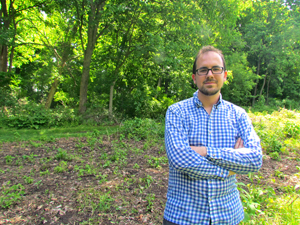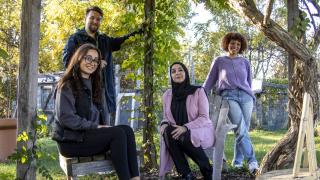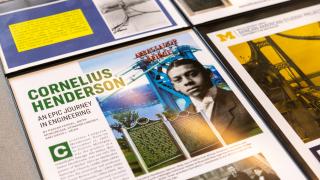

Robert Primeau (’05 B.S.) treks through muddy trails and avoids low-hanging branches on his way to work.
Amidst patches of colorful thistle and robust shrubs lie two 2,500-square foot plots. Some spots are free of vegetation, while other areas include piles of broken tree limbs and clusters of native species.
For the past few weeks, Primeau has transformed those plots into a makeshift office.
The University of Michigan-Dearborn alumnus is finalizing plans to create new contemporary gardens in the area that once housed Clara Ford’s historic rose gardens, located near the campus’ Environmental Interpretive Center (EIC).
“The idea of leaving some sort of legacy at my alma mater, albeit one that involves plants, is pretty exciting,” said Primeau, who is pursuing a master’s degree in landscape architecture at U-M. “I can’t wait to come back next summer and see how the plots have evolved.”
The plot history dates back 100 years when the Ford family contracted renowned designer Jens Jensen to map out their estate’s landscape architecture. Clara, wife of Ford Motor Co. founder Henry Ford, requested a rose garden be planted outside their Dearborn home.
However, after their passing, maintenance of the gardens proved too costly and the roses eventually died.
“Portions of the rose garden area have been allowed to go fallow over the years and are used for plant species’ surveys and other various laboratory and research activities on our campus,” said EIC Director David Susko.
Susko assigned EIC sustainability interns to help Primeau clear invasive species that inhabited the rose gardens. Primeau then strategically mapped out where certain plant species should be planted.
On June 21, once the plots are cleared of vegetation, Primeau hopes to recruit enough volunteers to help him plant 1,600 new plants.
The design aesthetic is natural, so visitors won’t see big, flashy flowers anywhere.
“I want to take a more natural approach with these plots,” Primeau said. “With the ‘greening’ of everything nowadays, it seems to be a much more popular design style. It also falls in line with the EIC’s goal of natural restoration.”
Plants aren’t cheap, though, so Primeau used funding from the Marshall Weinberg Internship Program to beautify the plots. U-M’s School of Natural Resources and Environment established the internship program to help graduate students, like Primeau, enhance their practical experience and professional development.





